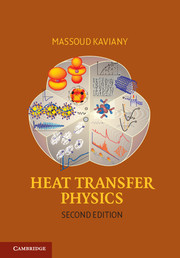Book contents
- Frontmatter
- Dedication
- Contents
- Preface
- Acknowledgments
- 1 Introduction and Preliminaries
- 2 Molecular Orbitals/Potentials/Dynamics and Quantum Energy States
- 3 Carrier Energy Transport and Transformation Theories
- 4 Phonon Energy Storage, Transport, and Transformation Kinetics
- 5 Electron Energy Storage, Transport, and Transformation Kinetics
- 6 Fluid Particle Energy Storage, Transport, and Transformation Kinetics
- 7 Photon Energy Storage, Transport, and Transformation Kinetics
- APPENDIX A Tables of Properties and Universal Constants
- APPENDIX B Derivation of Green–Kubo Relation
- APPENDIX C Derivation of Minimum Phonon Conductivity Relations
- APPENDIX D Derivation of Phonon Boundary Resistance
- APPENDIX E Derivation of Fermi Golden Rule
- APPENDIX F Derivation of Equilibrium, Particle Probability Distribution Functions
- APPENDIX G Phonon Contributions to the Seebeck Coefficient
- APPENDIX H Monte Carlo Method for Carrier Transport
- APPENDIX I Ladder Operators
- Nomenclature
- Abbreviations
- Glossary
- References
- Index
APPENDIX I - Ladder Operators
Published online by Cambridge University Press: 05 June 2014
- Frontmatter
- Dedication
- Contents
- Preface
- Acknowledgments
- 1 Introduction and Preliminaries
- 2 Molecular Orbitals/Potentials/Dynamics and Quantum Energy States
- 3 Carrier Energy Transport and Transformation Theories
- 4 Phonon Energy Storage, Transport, and Transformation Kinetics
- 5 Electron Energy Storage, Transport, and Transformation Kinetics
- 6 Fluid Particle Energy Storage, Transport, and Transformation Kinetics
- 7 Photon Energy Storage, Transport, and Transformation Kinetics
- APPENDIX A Tables of Properties and Universal Constants
- APPENDIX B Derivation of Green–Kubo Relation
- APPENDIX C Derivation of Minimum Phonon Conductivity Relations
- APPENDIX D Derivation of Phonon Boundary Resistance
- APPENDIX E Derivation of Fermi Golden Rule
- APPENDIX F Derivation of Equilibrium, Particle Probability Distribution Functions
- APPENDIX G Phonon Contributions to the Seebeck Coefficient
- APPENDIX H Monte Carlo Method for Carrier Transport
- APPENDIX I Ladder Operators
- Nomenclature
- Abbreviations
- Glossary
- References
- Index
Summary
This appendix deals with the boson and fermion ladder operators (i.e., annihilation and creation operators). These operators are not only used to find, for example, the eigenspectrum of a the quantum harmonic oscillator (Section 2.6.4); they are also in the second quantization to deal with systems of identical particles, such as, bosons (symmetric particles, e.g., phonons and photons) and fermions (anti-symmetric particles, e.g., electrons). This appendix covers the basics of the second quantization (as compared to the first quantization, of which a brief description is also given here), including the Fock (number) states and the basic forms of the creation and annihilation operators and their commutators (or anti-commutators, in the case of fermion operators). Finally, the use of these operators in creating arbitrary states, the number operators, field operators, and non-interacting and interacting Hamiltonians are discussed.
When dealing with bosons (phonon and photon, symmetric) and fermions (electrons, anti-symmetric), we must represent many identical particles. Consider a simple, non-interacting Hamiltonian
where each Hamiltonian Hi generates the identical eigenspectrum (∣ü1〉, ∣ü2〉, …, ∣üj〉, …) for all N particles. Subscripts on ü denote the state and subscripts on ∣üj〉 denote the particle occupying the jth state.
For example, consider a two-particle Hamiltonian with particles in the first two states. The boson and fermion states (∣ψB〉 and ∣ψF〉)are
where ∣üj〉i indicates the jth state (ü) of the ith particle. Note that ∣ü1〉1∣ü1〉2 is naturally symmetrized, such that no similar anti-symmetric system is possible (i.e., there is no equivalent fermion state since the Pauli exclusion principle holds).
Information
- Type
- Chapter
- Information
- Heat Transfer Physics , pp. 713 - 718Publisher: Cambridge University PressPrint publication year: 2014
